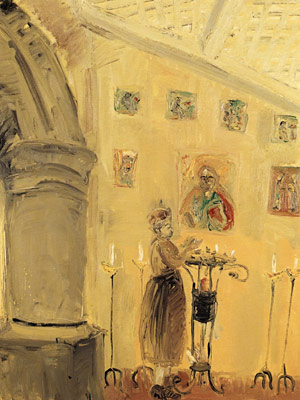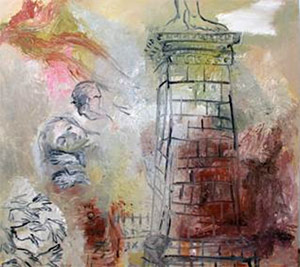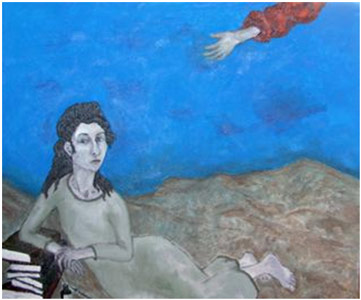|
Partou
Zia: Painter of Dreams
Helen Hoyle
In March 2003, No. 5 Porthmeor Studios opened its doors to Partou Zia.
For the next six months this would be her working space, under the terms
of the pioneering Tate St Ives Artists’ Residency Programme. Partou was
the first recipient of the award, initiated to support the development
of young artists in Cornwall. She was also the first woman to occupy
this historically significant studio, previously inhabited by Borlase
Smart, Ben Nicholson and then Patrick Heron. These iconic figures of
twentieth century art had each left in their wake a reputation larger
than life, together with liberal splatters of paint decorating every
available surface.
After the domestic homeliness of the Cottage Studio where she was
accustomed to working, Partou found the 100 square metres of the sky lit
No. 5 daunting. In her ‘Artist’s Journal’ she wrote: ‘I am not used to
the almost masculine spirit that pervades this room.’ However she soon
made the space her own, beginning with a series of large interiors in
which a red sofa, abandoned by Patrick Heron, became the central focus.
A few weeks later, her journal records: ‘The days pass like slow waves,
as I work in the great white studio.’
Each day Partou travelled by bus to the studio in St Ives from the
Newlyn home which she shared with her husband, the painter Richard Cook.
He told me that working in the Porthmeor Studios marked a ‘shift’ in
Partou’s career. The experience endowed her with a sense of
self-assurance. Here, for the first time, she had the freedom to tackle
large scale canvases which revealed a strongly developing sense of her
individuality.
Artistic partnerships can be fraught with pitfalls but Richard and
Partou were careful not to encroach on each other’s space, and always
maintained separate studios. Theirs was a mutually supportive
relationship underpinned by a deep understanding of their partner’s
work. Respecting each other’s artistic judgement, they shared in the joy
of one another’s success. Whereas Richard’s work evolves out of a direct
engagement with the confluence of earth, sea and sky, Partou’s affinity
with nature is merged with an interior dreamscape whose recurring motifs
articulate a journey of self-discovery. Many of their paintings include
images of each other.
 Cornwall
became Partou’s home in 1993. She was born in 1958 in Persia,
experiencing a childhood rooted in the culture and traditions of an
ancient civilisation. From her grandmother she assimilated the epic
poems and fables, rich in mythological allusion, which had been handed
down the generations. In contrast, Partou’s father turned his back on
tradition and became a communist, with no time for the mystical. When in
1970 his dissident activities attracted the attention of the Shah’s
regime, the family fled Tehran for a new life in London, under the guise
of a holiday. To the eleven-year old Partou this experience was
traumatic, since she had no idea that she would never return to live in
the country of her birth. Cornwall
became Partou’s home in 1993. She was born in 1958 in Persia,
experiencing a childhood rooted in the culture and traditions of an
ancient civilisation. From her grandmother she assimilated the epic
poems and fables, rich in mythological allusion, which had been handed
down the generations. In contrast, Partou’s father turned his back on
tradition and became a communist, with no time for the mystical. When in
1970 his dissident activities attracted the attention of the Shah’s
regime, the family fled Tehran for a new life in London, under the guise
of a holiday. To the eleven-year old Partou this experience was
traumatic, since she had no idea that she would never return to live in
the country of her birth.
Torn from her roots and suffering from a sense of displacement in her
new environment, Partou sought solace in the literary and philosophical
riches of her Eastern cultural heritage. She also steeped herself in the
works of western writers including Virginia Woolf, Luce Irigary, Carl
Jung and the poetry of W B Yeats. Her innate linguistic fluency
developed over the years into a highly original talent. With a lightness
of touch, Partou imbued her writings - which included prose poetry,
short stories, plays and philosophical reflections - with the truth of
universal wisdom.
After completing her schooling in north London, Partou obtained a degree
in Art History at the University of Warwick. This was followed in 1991
by a BA Hons. in Fine Art at the Slade. After moving to Cornwall she
continued her studies at Falmouth College of Art, where she was awarded
a PhD in 2001.
Partou’s first group exhibition took place in Manchester in 1989. From
then on her work was seen in Southampton, Liverpool and Exeter, as well
as a variety of venues in London and Cornwall. In 1997 her growing
reputation was acknowledged with an inaugural solo exhibition in London,
followed by solo shows at Newlyn Art Gallery, the Royal Cornwall Museum,
Plymouth Arts Centre and several galleries in the capital.
Early in Partou’s career, landscape provided the main inspiration for
her work. The quest of the individual for the divine was a developing
theme. A fascination for religious iconography was manifested in
depictions of the overlooked corners of church interiors. Everyday
objects such as books, lamps and chairs inhabited her images of domestic
scenes, suggesting a desire to capture the essence of her long-lost
childhood home. Her canvases at this time were dominated by an energetic
application of heavily impastoed yellow, which for her represented the
spiritual (eg 'Morning Prayer' above). Self-portraits, some of them
nude, also formed an important part of her oeuvre, not only as a means
of asserting her identity as a woman and a painter, but in order to
reveal her intuitive self.
 The
opportunity of working at Porthmeor Studios gave Partou a tremendous
boost in confidence. Under the terms of the residency, she was required
to select the work of an artist from the Tate collection to use as a
framework for her output. Partou had first encountered the paintings of
William Blake in the Tate. Their visionary timelessness, emanating from
a different reality, resonated with the sense of dislocation she was
experiencing as a cultural and linguistic émigré. Appropriately, the
choice for her residency was Blake’s epic poem, ‘The Four Zoas’, rich in
symbolism and classical references. As a consequence of the expulsion
from the Garden of Eden, the individual shatters into the four Zoas –
passion, reason, sensation and instincts – setting up a creative
conflict. The concept of the ‘shattered individual’ chimed with Jung’s
idea of the split personality. The
opportunity of working at Porthmeor Studios gave Partou a tremendous
boost in confidence. Under the terms of the residency, she was required
to select the work of an artist from the Tate collection to use as a
framework for her output. Partou had first encountered the paintings of
William Blake in the Tate. Their visionary timelessness, emanating from
a different reality, resonated with the sense of dislocation she was
experiencing as a cultural and linguistic émigré. Appropriately, the
choice for her residency was Blake’s epic poem, ‘The Four Zoas’, rich in
symbolism and classical references. As a consequence of the expulsion
from the Garden of Eden, the individual shatters into the four Zoas –
passion, reason, sensation and instincts – setting up a creative
conflict. The concept of the ‘shattered individual’ chimed with Jung’s
idea of the split personality.
Embarking on her project, Partou abandoned the security of doing
preparatory drawings. The dominant yellow of her earlier works gave way
to a stronger palette employing colours which related to her interior
world. Painting directly onto large canvases endowed her work with
fluency and rhythm. She incorporated aspects of the landscape idiom into
‘dreamscapes’ which strove to capture the intangible, poised between
memory and the present. She described this as an attempt to ‘paint
thought’. While clues to her iconography can be found in her writing,
Partou’s paintings resist easy interpretation. Interviewed about the
residency canvases, she said: ‘In a way the paintings themselves must
remain locked mysteries … otherwise they are playing to an audience.’
‘The Sleep of Hands’ (right above) pays homage to classical civilisation
in its depiction of a monument. The presence of a pair of bare feet on
the plinth introduces a note of irreverence. Here Partou employs imagery
such as multiple pairs of hands, together with the head of a sleeping
woman, watched over by a mysterious, ethereal figure which has been
described as her ‘alter ego’ and which makes an appearance in much of
her work. Pairs of eyes – a reference to one of Blake’s illustrations –
feature in her paintings from this period onwards, as does a bird
(sometimes an owl) in the guise of a messenger.
 Partou’s
occupation of No. 5 culminated in a solo show at Tate St Ives in October
2003, entitled ‘Entering the Visionary Zone’. The canvases she had
produced during her time at Porthmeor Studios were praised for their
‘episodic, cinematic quality’. Partou’s
occupation of No. 5 culminated in a solo show at Tate St Ives in October
2003, entitled ‘Entering the Visionary Zone’. The canvases she had
produced during her time at Porthmeor Studios were praised for their
‘episodic, cinematic quality’.
The Tate residency marked the start of the mature phase of Partou’s
career. A few months afterwards, the British Museum purchased one of her
self-portrait drawings. This was a significant moment for her, as she
felt for the first time a sense of belonging in her adopted country.
Solo and group exhibitions followed at the London gallery, Art First.
In 2004 her greatly loved grandmother died, aged 94. Partou’s sorrow at
her passing was all the more acute for the realisation that the last
remaining link with her ‘beloved Iran’ was finally severed. She wrote
that the old lady’s death left a ‘great abyss which will not be
traversed in my lifetime’.
In 2005 Partou was diagnosed with cancer. Instead of succumbing to the
inevitable, she redoubled her efforts, determined to make the most of
the time left to her. On a visit to her favourite island, Tresco, which
reminded her of childhood holidays on the Caspian Sea, she produced a
particularly beautiful self-portrait (left above).
The paintings from the last few months of her life reflect a change of
mood. The intense energy of her earlier canvases has given way to a more
contemplative application of paint, as a consequence of her failing
strength. In ‘40 Nights and 40 Days’ (below) she reclines, in classical
garb, resting her elbow on a pile of books – an indication, perhaps,
that her work is done. She seems to be gazing beyond the present, the
outstretched hand ready to guide her on the next step of her journey.
 Partou
Zia died in 2008, on 19th March, the eve of the Iranian New Year, Noruz,
which also celebrates the arrival of spring. She was forty-nine. For a
month following her death, ‘40 Nights and 40 Days’ was hung in the
entrance to Tate St Ives, as a tribute. Later that year a posthumous
exhibition of her work entitled ‘In the Face of Wonder’ took place at
the Exchange Gallery. More recently, in October 2010, Partou and
Richard’s work was shown together in ‘Meetings of Dreams’ at the Wills
Lane Gallery in St Ives. Partou
Zia died in 2008, on 19th March, the eve of the Iranian New Year, Noruz,
which also celebrates the arrival of spring. She was forty-nine. For a
month following her death, ‘40 Nights and 40 Days’ was hung in the
entrance to Tate St Ives, as a tribute. Later that year a posthumous
exhibition of her work entitled ‘In the Face of Wonder’ took place at
the Exchange Gallery. More recently, in October 2010, Partou and
Richard’s work was shown together in ‘Meetings of Dreams’ at the Wills
Lane Gallery in St Ives.
Partou was a highly gifted individual of charm and vitality, whose
compassion and sense of fun enriched the lives of those who knew her.
For Richard, her loss has been hard to bear. However, he says that the
force of bereavement has transformed his own art practice in such a way
as to enable him to find Partou once more within it. Her paintings and
writings live on, as testament to an extraordinary talent.
Partou and Richard’s work
can be seen at ArtFirst and Wills Lane Gallery. Special thanks to
Richard Cook.
© 2011 Helen Hoyle
www.cornishmuse.blogspot.com
Richard Cook is the copyright holder of images by Partou Zia.
|